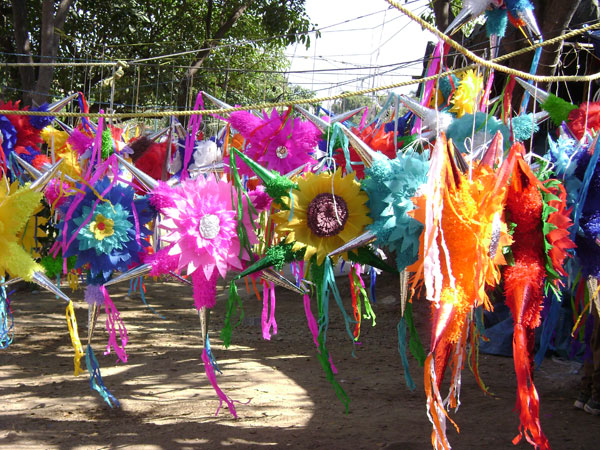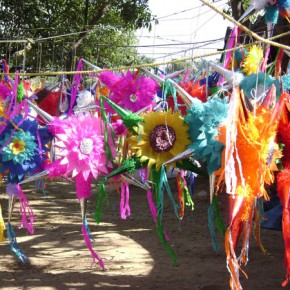Mexico is predominantly a Catholic country, although every possible religion is very likely represented here…
Mexico has many of the same Christmas traditions found the world over in Judeo-Christian countries, but like all places they have their own versions and regional differences, with unique customs particular to Mexico. Independent of religious celebration, the holidays in Mexico are a time for gatherings of friends and family, and if you will be in Mexico during the holiday season you might enjoy taking the time to learn about Mexico’s holiday traditions.
Nacimientos
During the Christmas season, Mexico’s craft markets sell thousands of figures for the nacimientos, the elaborate nativity scenes created in homes, churches and even offices throughout the country. If you want to create your own, take this opportunity to pick up some Mexican-crafted pieces. The nativity scenes created on tabletops often resemble whole villages, with mountains, rivers and lakes surrounding them. There are models of markets, musicians, children playing, dancers and women making tortillas. Look out for the figures unique to Mexican culture, such as the rooster that announces the birth of Christ, and Lucifer lurking in the bushes to distract the shepherds. One of the biggest markets takes place in the city of Guadalajara, Mexico’s second city, north-west of the capital. Markets are usually held December – February on Sundays and Thursdays, but check with the local tourist office first.
Posadas
Throughout the country, neighborhoods and households host vibrant parties and processions, known as posadas, in remembrance of Mary and Joseph’s journey to Bethlehem. The term posada refers to the lodging that the couple sought in the city. Guests and hosts alike re-enact the tale of their search by singing traditional carols at the doors of the party. Traditionally the host may only open the doors once they have guessed the identities of those outside. It is common for children to be dressed up as Joseph and Mary and for there to be a genuine donkey present. Once the guests have entered the house, children break open piñatas. In the past these were seven-pointed stars representing the seven deadly sins, but they are commonly being replaced with vessels in the shapes of plants and animals. In Mexico the piñata is perceived as a demon with his belly bursting with evil. Children must break the object open in a symbolic gesture to let good overcome the evil. When broken the contents of the piñata reveal a broken earthenware jar bearing sweets, toys and fruit for the children to gorge on. These celebrations happen during December 16-24, and have long been a part of Mexican culture. Their version of the Passion plays quite often feature devils as well as the traditional characters. At the very end of the evening an aguinaldo (bonus) is handed out to the children present, consisting of dried fruit and other goodies.
Misa de Gallo
On Christmas Eve, Roman Catholic Mexicans head to their local church to celebrate the late night Misa de Gallo. This literally translates as rooster’s mass, but is usually known as midnight mass. Afterwards, families celebrate with a traditional meal. The mass is celebrated with the arrival of the final procession, or posada, of the season, where locals honor the new born messiah in his manger. There are traditional indigenous dances, music and hugs of love and peace are shared throughout the congregation. After the mass, the celebrants head off for a traditional meal. There are gifts for the children, the smashing of the piñata, the lighting of sparklers and general merrymaking throughout the night. Christmas Day is quiet as everyone recovers and eats the leftovers.
Dia de los Inocentes
A few days after Christmas on December 28, a holiday called Dia de los Inocentes,(The Day of the Innocents) is said to be a religious commemoration of the day that Herod sent out his troops to kill all newborn children in an attempt to eradicate the threat of a new king. Actually, the day is more akin to April Fool’s day, with gags and jokes being played. Mexicans ask to borrow objects of value or money from friends, creating elaborate stories, problems or tragedies to convince their prey. If someone falls victim to this, they are given sweets, miniature toys or a silly gift in return but they also have to face the jokes and name calling for the rest of the day. So, you have been warned. Don’t fall for your friends’ stories and don’t lend anything to anyone, but if you do…just remember, it’s only a little harmless fun!
Los Reyes Magos
The final holiday of the Christmas season is on January 6, Los Reyes Magos (Three Kings Day), celebrating the Epiphany (as it is usually called in English) the Mexican way, with gifts for the children and a feast with family or friends. Roman Catholics celebrate the arrival in Bethlehem of the Three Wise Men; Melchior, Gaspar and Baltazar, bearing gifts of gold, frankincense and myrrh for the new-born Son of God. Mexican children receive presents, having filed their letter of request a few days before (in the same way children often write to Santa Claus before Christmas). In Mexico City, the children often go to the Alameda Park, where they can have their photograph taken with the Three Kings. The park is lined with food and toy stalls. Helium-filled balloons are also on sale, so the children can attach their letters to them and let their wish be carried up to the sky. The night before, they leave their old shoes under their bed or in the living room and hope to find presents next to them in the morning. Often they leave cookies and milk for the Three Kings and even hay and water for the animals. While the children play with their new gifts, the adults prepare the Merienda de Reyes, the meal that friends and families have on this day. It is traditional to have a Rosca de Reyes, a round sweet cake/bread decorated with crystallized fruit. A plastic baby (representing Jesus) is hidden in the cake (symbolizing being hidden from King Herod’s men). Whoever gets the plastic figure is expected to play host to all those present (and make tamales for all) on February 2, for Candelaria (Candlemas).
So, no matter what your beliefs or religion may be, there is always a reason to celebrate this time of year. And if you decide to participate or just happen upon one of the many Mexican celebrations, I hope we all find some way to enjoy this time with our friends and family. Whether here on the beach, or in your home town, let’s make this a holiday season to remember.
- Piñatas on sale during Christmas. Photo by Catherine Krantz.
- Figures for a nacimiento, including the Christmas rooster. Photo by Catherine Krantz.
- Poinsettias, Flor de Noche Buena, (“Christmas Flower”) in Spanish, are native to Mexico. Photo by Catherine Krantz.
- Nativity scenes for sale in the market. Photo by Catherine Krantz.
- Santa and other piñatas in the market. Photo by Catherine Krantz.









